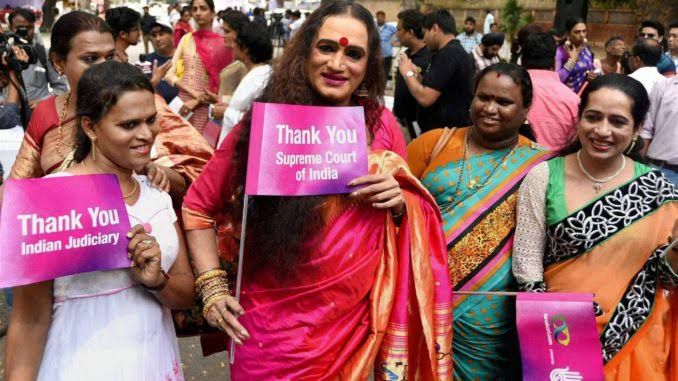Author: RITU PARNA, National Law University, Meghalaya
To the Point
The Supreme Court of India, in a historic Constitution Bench judgment in Navtej Singh Johar v. Union of India (2018), read down Section 377 of the Indian Penal Code (IPC), thereby decriminalizing consensual homosexual relations between adults. The Court affirmed that sexual orientation is a natural and immutable attribute, and criminalizing it amounts to a grave violation of fundamental rights under Articles 14, 15, and 21 of the Constitution. This judgment effectively overruled the regressive stance in Suresh Koushal v. Naz Foundation (2013) and marked a monumental leap in India’s constitutional journey toward inclusion and dignity.
Use of Legal Jargon
Constitutional Morality: Preferred over “popular morality” in upholding individual rights against majoritarian bias.
Manifest Arbitrariness: The doctrine used to strike down Section 377 for its irrational classification and lack of intelligible differentia.
Right to Privacy: Reaffirmed as a core element of personal liberty under Article 21 post-Puttaswamy.
Egalitarian Jurisprudence: Judicial commitment to the principles of equality and non-discrimination, as enshrined in Articles 14 and 15.
Transformative Constitutionalism: Interpreting the Constitution as a living document aimed at fostering an inclusive, pluralistic society.
The Proof
The Court’s rationale was grounded in constitutional text, evolving jurisprudence, and a robust understanding of human dignity:
Violation of Article 14 (Equality before Law): Section 377 created an unreasonable classification by criminalizing a specific sexual orientation, thereby lacking intelligible differentia or a rational nexus with legitimate state interest.
Infringement of Article 15 (Non-discrimination): Though sexual orientation isn’t explicitly mentioned, the Court recognized it as an analogous ground under “sex,” broadening its interpretive horizon in line with liberal constitutionalism.
Article 21 (Right to Life and Personal Liberty): The Court declared that the liberty to choose one’s partner and express love physically is integral to bodily autonomy, mental integrity, and dignity.
Puttaswamy & Privacy: The nine-judge bench in Justice K.S. Puttaswamy (2017) established privacy as a fundamental right, setting a binding precedent. This judgment paved the legal pathway to recognizing consensual sexual conduct as a private domain outside state interference.
Overruling Suresh Koushal: The 2013 ruling was held to be per incuriam, as it failed to appreciate the scope and depth of fundamental rights affected by criminalizing consensual same-sex intimacy.
Abstract
The Navtej Singh Johar verdict signifies a constitutional metamorphosis—where the Supreme Court interpreted the Indian Constitution not merely as a legal charter, but as a moral compass in pursuit of equality, liberty, and dignity. By reading down Section 377 IPC, the Court decriminalized consensual homosexual activity, embracing the tenets of constitutional morality, individual autonomy, and egalitarian justice. The judgment resonated beyond the LGBTQIA+ community; it redefined Indian democracy’s approach to minority rights and the state’s duty in nurturing a pluralistic society. While the judgment is historic, the battle for full inclusion—marriage equality, adoption rights, anti-discrimination legislation—continues.
Case Laws
Navtej Singh Johar v. Union of India (2018)
The case that finally struck down the criminalization of consensual same-sex relationships. A five-judge Constitution Bench invoked Articles 14, 15, and 21 to read down Section 377 IPC.
Justice K.S. Puttaswamy (Retd.) v. Union of India (2017)
Declared the right to privacy as intrinsic to the right to life and liberty under Article 21. Paved the way for decriminalizing sexual autonomy and intimacy.
National Legal Services Authority (NALSA) v. Union of India (2014)
Recognized transgender persons as the ‘third gender’ and emphasized dignity, identity, and autonomy. Supported the constitutional inclusiveness of sexual and gender minorities.
Obergefell v. Hodges (U.S. Supreme Court, 2015)
Legalized same-sex marriage in the U.S. The Indian court cited this case to reinforce global trends toward the protection of queer rights.
Dudgeon v. United Kingdom (European Court of Human Rights, 1981)
Declared criminalization of homosexual acts as a violation of Article 8 (Right to Private Life), shaping international human rights discourse.
Conclusion
Navtej Singh Johar v. Union of India is a judicial celebration of liberty, love, and constitutional morality. The Court’s reliance on transformative interpretation elevated the dignity of a long-oppressed community, moving beyond colonial hangovers and societal stigma. The judgment doesn’t merely mark legal decriminalization—it is a clarion call for societal acceptance and equal citizenship. Yet, the legal revolution must be followed by legislative action to address same-sex marriage, adoption, employment discrimination, and healthcare equality. The Indian Constitution, as a living document, now stands reaffirmed as an ally of inclusivity and dignity.
FAQs
1. What was Section 377 IPC, and how did it impact LGBTQIA+ persons?
Section 377 criminalized “carnal intercourse against the order of nature,” which was interpreted to include consensual same-sex relations. It led to harassment, blackmail, and criminalization of the LGBTQIA+ identity.
2. Does the judgment mean same-sex marriage is now legal in India?
No. The judgment decriminalized same-sex intimacy but did not address marriage, adoption, or inheritance. These remain areas for future legal development.
3. What is ‘constitutional morality’ and how did it influence the judgment?
‘Constitutional morality’ refers to adherence to constitutional values such as liberty, equality, and fraternity, even when they conflict with societal norms or prejudices. The Court held that individual rights must not be sacrificed at the altar of majoritarian beliefs.
4. Is the protection only for homosexual men?
No. The judgment covers all LGBTQIA+ persons. It is gender-neutral and inclusive in recognizing the sexual autonomy of all individuals.
5. Does this judgment affect transgender persons?
Yes. While NALSA (2014) laid the groundwork for transgender rights, Johar strengthens these protections by safeguarding the right to sexual expression and privacy.
6. What international laws were referred to in this case?
The Court referenced cases from the U.S., South Africa, U.K., and European Court of Human Rights, aligning India’s jurisprudence with global constitutional human rights standards.
7. Can a private employer still discriminate against LGBTQIA+ employees?
There is no specific anti-discrimination law yet. However, the spirit of Johar supports equal treatment, and such discrimination could be constitutionally challenged.
8. What happens if a police officer still uses Section 377?
Post-Johar, Section 377 only applies to non-consensual acts, bestiality, or minors. Any use of it against consensual adult relationships is unconstitutional and void.
9. What legal steps should follow this judgment?
Enactment of anti-discrimination laws, civil union/marriage rights, adoption and parenting frameworks, and public awareness reforms are necessary to ensure full equality.
10. Why is this case considered a turning point in Indian legal history?
It overturned a 157-year-old colonial law, reaffirmed the dynamic nature of constitutional rights, and recognized the LGBTQIA+ community as full citizens of India—equal in dignity, liberty, and rights.



